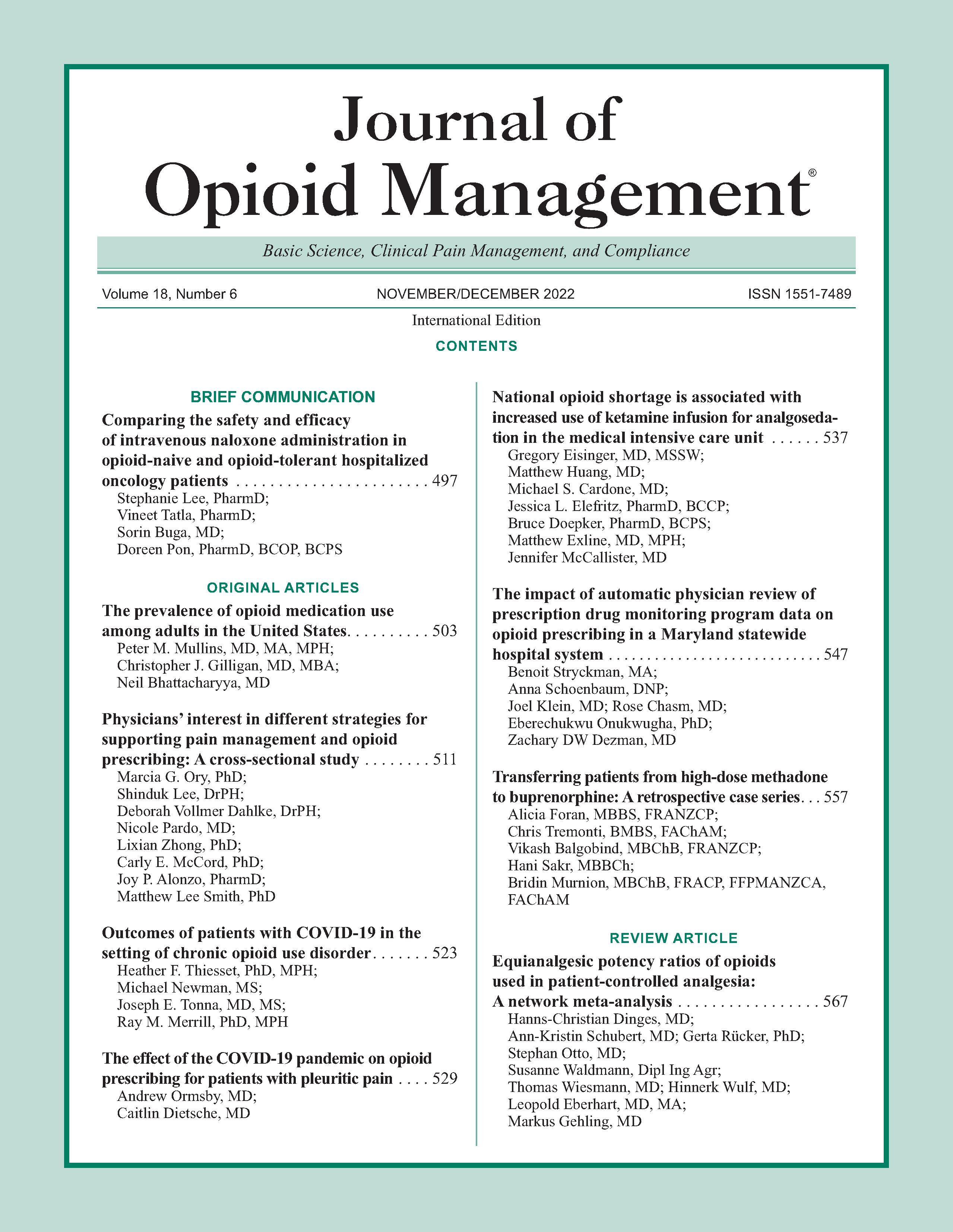The prevalence of opioid medication use among adults in the United States
DOI:
https://doi.org/10.5055/jom.2022.0745Keywords:
opioids, prevalence, pain managementAbstract
Objective: More than one in five American adults experiences chronic pain, and numerous approaches can be used to treat chronic pain. Opioid analgesics are commonly used to treat pain though precise estimates of the prevalence of opioid analgesic use vary widely. This study sought to determine the prevalence of opioid use for pain among adults in the United States.
Methods: We performed a retrospective analysis of the National Health Interview Survey, a national-level household-based annual survey of self-reported health status of US adults, using a chronic pain module introduced in the 2019 edition. We examined overall rates of opioid medication use for pain and correlates of opioid use using survey-weighted analyses.
Results: We found 30.8 million adults (95 percent CI: 29.3-32.3 million), or 12.3 percent (11.8-12.8) of the population, had used opioids for pain in the preceding 12 months, while 9.3 million (8.6-10.0 million), or 3.7 percent (3.5-4.0), had used opioids for chronic pain in the preceding 3 months. Individuals reporting pain every day were more likely to have used opioids than those experiencing pain less frequently. Individuals who had tried other methods such as physical therapy and self-management programs were more likely to have used opioids. Individuals who used opioids for pain were more likely to report poorly controlled pain, with 38.0 percent (31.5-45.0) reporting their pain management was “not at all effective.”
Conclusions: Opioid use for chronic pain is common and frequently part of a multimodal and multidisciplinary approach.
References
Dale R, Stacey B: Multimodal treatment of chronic pain. Med Clin North Am. 2016; 100(1): 55-64. DOI: 10.1016/j.mcna.2015.08.012.
Gatchel RJ, Peng YB, Peters ML, et al.: The biopsychosocial approach to chronic pain: Scientific advances and future directions. Psychol Bull. 2007; 133(4): 581-624. DOI: 10.1037/0033-2909.133.4.581.
Ventafridda V, Saita L, Ripamonti C, et al.: WHO guidelines for the use of analgesics in cancer pain. Int J Tissue React. 1985; 7(1): 93-96.
Gregorian RS, Gasik A, Kwong WJ, et al.: Importance of side effect in opioid treatment: A trade-off analysis with patients and physicians. J Pain. 2010; 11: 1-14.
Boudreau D, Von Korff M, Rutter CM, et al.: Trends in long-term opioid therapy for chronic non-cancer pain. Pharmacoepidem Drug Safe. 2009; 18(12): 1166-1175.
Bohnert ASB, Guy GP Jr, Losby JL: Opioid prescribing in the United States before and after the centers for disease control and prevention's 2016 opioid guideline. Ann Intern Med. 2018; 169(6): 367-375. DOI: 10.7326/M18-1243.
Jeffery MM, Hooten WM, Henk HJ, et al.: Trends in opioid use in commercially insured and Medicare advantage populations in 2007-16: Retrospective cohort study [published correction appears in BMJ. 2018 Nov 14;363: K 4825]. BMJ. 2018; 362: K2833. DOI: 10.1136/bmj.k2833.
Yong RJ, Mullins PM, Bhattacharyya N: Prevalence of chronic pain among adults in the United States. Pain. 2021; DOI: 10.1097/j.pain.0000000000002291.
Noble M, Treadwell JR, Tregear SJ, et al.: Long-term opioid management for chronic noncancer pain. Cochrane Database Syst Rev. 2010; CD006605. DOI: 10.1002/14651858.CD006605.pub2.
Busse JW, Wang L, Kamaleldin M, et al.: Opioids for chronic noncancer pain: A systematic review and meta-analysis. JAMA. 2018; 320(23): 2448-2460. DOI: 10.1001/jama.2018.18472.
Chou R, Hartung D, Turner J, et al.: Opioid Treatments for Chronic Pain. Rockville, MD: Agency for Healthcare Research and Quality, 2020.
Corli O, Damia G, Galli F, et al.: Lack of efficacy: When opioids do not achieve analgesia from the beginning of treatment in cancer patients. Cancer Manag Res. 2019; 11: 10337-10344. DOI: 10.2147/CMAR.S211818.
Chou R, Turner JA, Devine EB, et al.: The effectiveness and risks of long-term opioid therapy for chronic pain: A systematic review for a national institutes of health pathways to prevention workshop. Ann Intern Med. 2015; 162(4): 276-286. DOI: 10.7326/M14-2559.
Lee M, Silverman SM, Hansen H, et al.: A comprehensive review of opioid-induced hyperalgesia. Pain Phys. 2011; 14(2): 145-161.
Published
How to Cite
Issue
Section
License
Copyright 2005-2025, Weston Medical Publishing, LLC and Journal of Opioid Management. All Rights Reserved.











